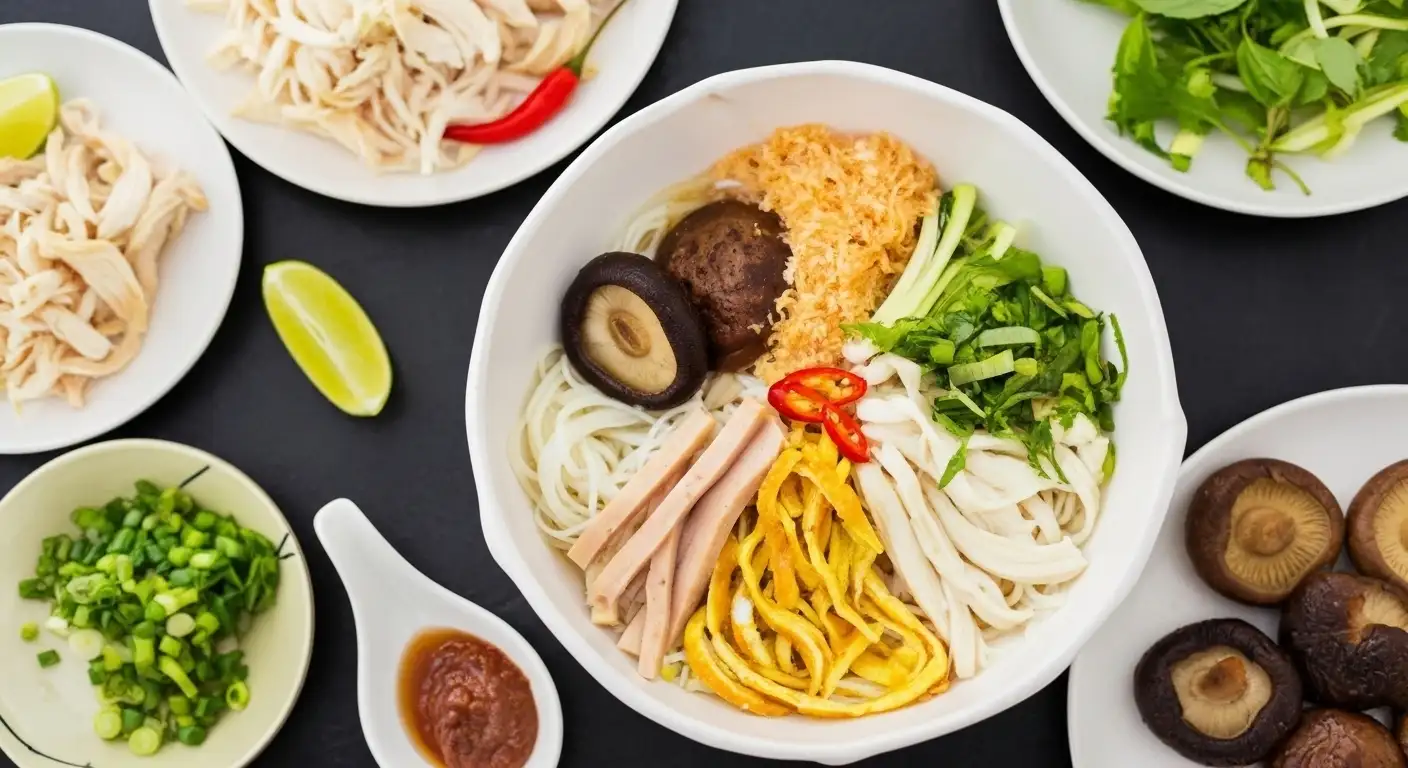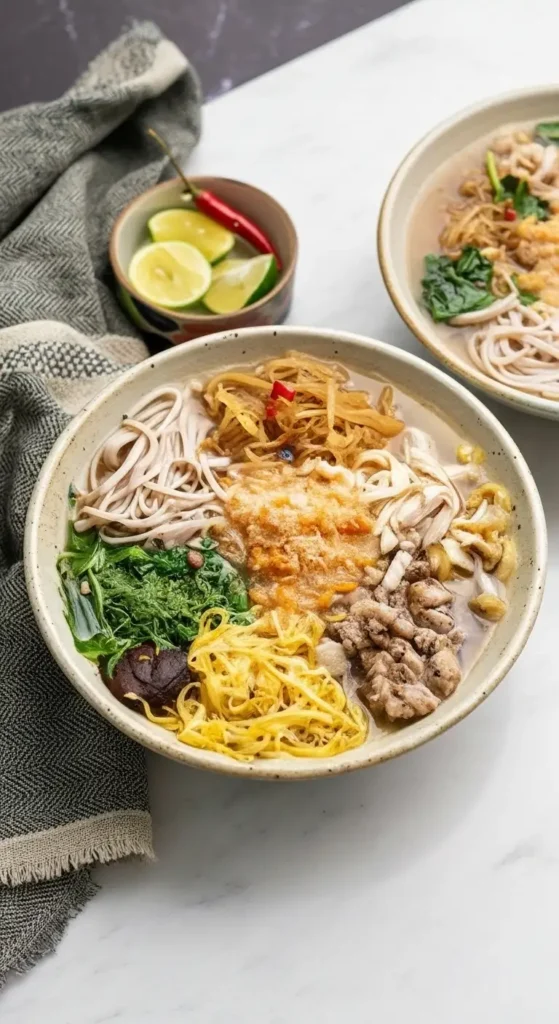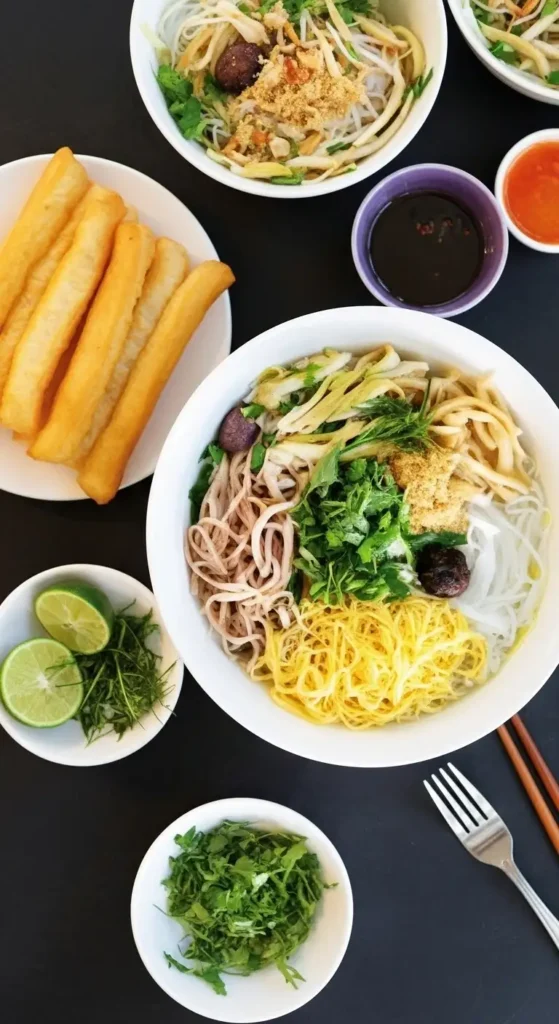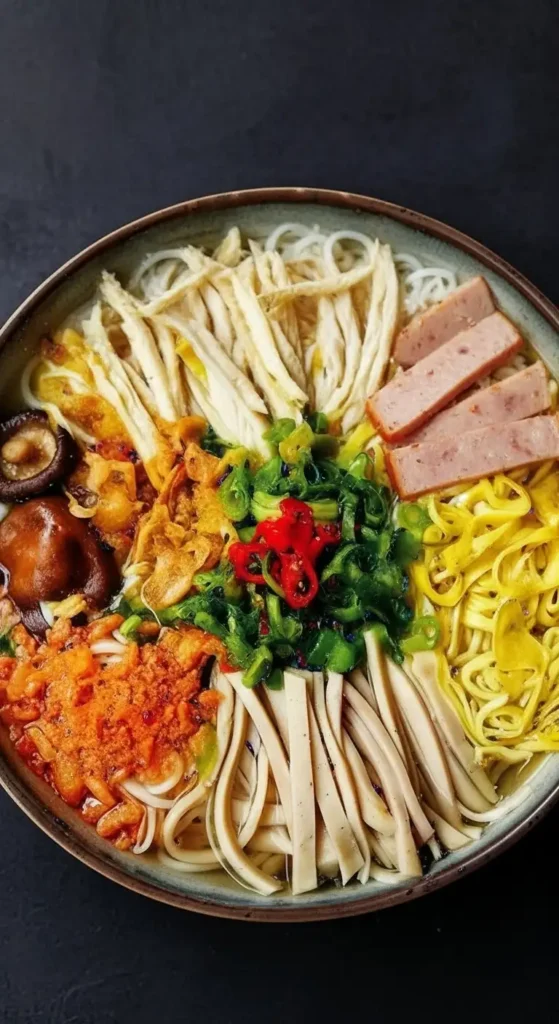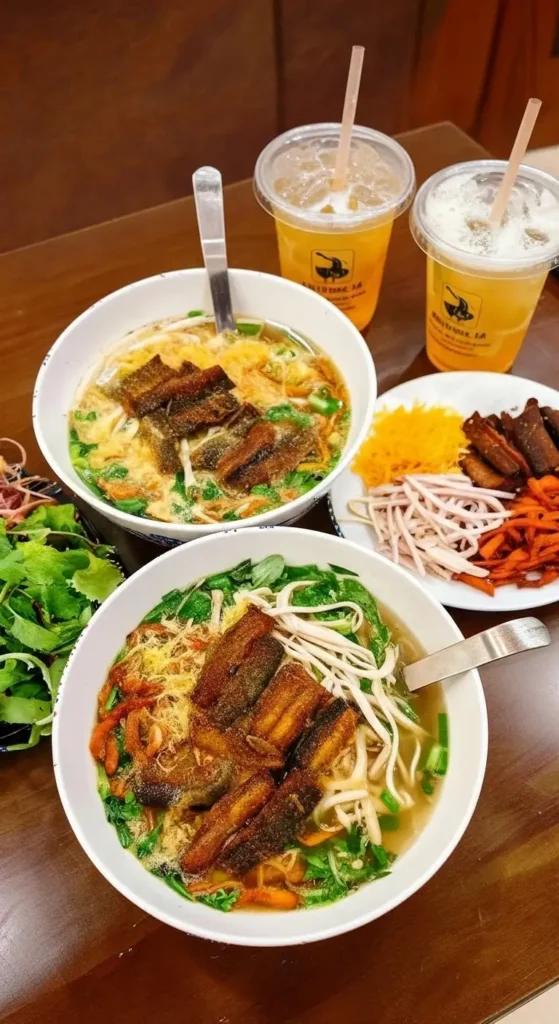Bún Thang (pronounced “Boon Tahng”) is not just a noodle soup; it is a masterpiece of balance and refinement, representing the height of culinary elegance in Northern Vietnam, particularly in Hanoi. Its name roughly translates to “ladder” or “scale,” symbolizing the harmonious combination of numerous, meticulously prepared ingredients. Originating as a sophisticated dish to utilize leftovers from the Lunar New Year (Tết) celebration, it remains a symbol of Hanoian finesse.

Bún Thang: The Basics
The Broth: The foundation of Bún Thang is its incredibly clear, delicate, and savory broth. It is typically simmered for hours using chicken and pork bones, along with aromatics like roasted ginger and dried shallots. The broth’s distinctive savory depth comes from dried ingredients like dried shrimp and sometimes dried shiitake mushrooms. It is light, subtly sweet, and mildly seasoned, relying on the quality of its components rather than heavy spice.
The Noodle (Bún): It uses fine, thin rice vermicelli noodles (bún).
The Meticulous Toppings: The defining characteristic of Bún Thang is its presentation, featuring nearly 20 components, each prepared separately and laid out in colorful, fine ribbons across the bowl like a work of art:
Shredded Chicken: Tender, finely shredded meat from the broth-making process.
Thin-Sliced Omelet: Eggs are beaten, fried into thin crêpes, and then sliced into delicate, long threads.
Vietnamese Pork Sausage (Chả Lụa): Cut into thin, matchstick-sized pieces.
Shrimp Floss (Chà Bông Tôm): Dried, fluffy, finely ground shrimp, adding a burst of umami and texture.
Herbs and Aromatics: Finely chopped green onions and cilantro.
Variations of Bún Thang
Unlike some other Vietnamese noodle soups that have wild regional variations, Bún Thang is strongly tied to its Hanoi roots and tradition. The differences are generally slight variations in richness or specific toppings:
Classic Bún Thang Hà Nội (Hanoi): This is the gold standard. It emphasizes a light, clear broth and the visual precision of the main four toppings (chicken, egg, chả lụa, shrimp floss). Historically, a drop of rare Ca Cuống (giant water beetle essence) was added for a unique floral aroma, though this is rarely done today.
Heartier Variations: Some modern or Southern-influenced versions might include:
Mushrooms: Dried shiitake mushrooms are often included in the broth but sometimes served as a topping.
Pickled Radish or Beetroot: Used to add a vinegary, crunchy contrast.
Quail Eggs: Added for extra richness.

How to Eat Bún Thang
Eating Bún Thang is a contemplative experience, meant to be appreciated for its balance of flavors and textures.
Admire the Arrangement: Before diving in, take a moment to appreciate the beautiful, circular arrangement of colors in the bowl.
Add the Condiments: The bowl is typically served with a lime wedge, pepper, and most importantly, a tiny spoon of mắm tôm (fermented shrimp paste).
The Mắm Tôm Essential: In Hanoi, mắm tôm is an indispensable condiment for Bún Thang for those who can handle its pungent flavor. You should add a small amount of the paste to your broth, squeeze a few drops of lime juice onto it, and stir vigorously to blend the flavors. This adds a powerful, salty umami kick that Hanoians insist brings the delicate broth to life. (Note: If you are averse to strong fermented flavors, you may omit the mắm tôm, but you will miss the traditional experience.)
Mix Gently: Unlike Bún Bò Nam Bộ, which is thoroughly tossed, Bún Thang is enjoyed by gently mixing the toppings and noodles with the broth as you eat, allowing you to sample the layers of texture with each spoonful.
Regional Differences
Bún Thang is overwhelmingly a specialty of Northern Vietnam, and its identity is inseparable from Hanoi’s sophisticated culinary traditions.
| Region | Regional Culinary Style | Bún Thang Presence and Style | Local Perspective |
|---|---|---|---|
| Northern Vietnam | Delicate, savory, and clean flavors; high value placed on ingredient quality and presentation. | The Origin and Standard. The focus is on the clear, non-fatty broth and the meticulously sliced, colorful toppings. Mắm Tôm is considered the traditional, necessary condiment. | Bún Thang is a prized, elegant dish—a celebratory meal, not typically consumed daily like Phở or Bún Chả. |
| Central Vietnam | Bold, salty, and spicy; focus on strong flavors and visual appeal. | Infrequent. While central regions feature many excellent noodle dishes (like Bún Bò Huế), Bún Thang does not belong to the Central Vietnamese culinary canon and is rarely found. | Locals focus on their own complex noodle soups and spicy dishes. |
| Southern Vietnam | Sweet, rich, generous portions; open to diverse influences. | Available, but adapted. Restaurants may serve Bún Thang, but the broth tends to be slightly sweeter and richer, and the overall dish might be more heavily garnished or include additional meats, reflecting the Southern palate for abundance. | It is seen as a distinct, Northern specialty when served in the South. |
